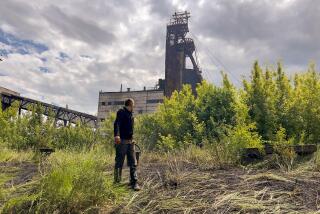Bad Year for Roads Adds Up to Good Year for Salt Miners
- Share via
RETSOF, N.Y. — With their tarpaulin tops flapping madly, tractor-trailer trucks laden with road salt thunder across the Genesee River valley, bound for icy points from Maine to the Mason-Dixon line.
A quarter-mile beneath the snowy farmland, miners ladle up the precious winter commodity in 17-ton scoops, the headlights of the front-end loaders dancing over great crystal pillars in a honeycomb the size of Manhattan.
Never have so many cried out so loudly for so much de-icer salt. And though his shoulders ache from pulling levers, and his face is florid from 80-hour workweeks, Larry Dunn Jr. looks equal to the task.
“It’s been rough, but the paycheck’s been good,” growls Dunn, a bearlike presence in the locker room during the afternoon shift change. Two packs of cigarettes are jammed in his shirt pocket.
“I’d rather see it go like this than in 1982, when I was laid off. That was a lot harder on me--not having no paycheck for 11 months--than working like this for two months. When the snow don’t fly, the business don’t go.”
Dunn is grossing up to $2,500 a week at Retsof, the largest rock-salt mine in the Americas. It hasn’t been this busy since he first joined his father down the 1,100-foot-deep elevator shaft 17 1/2 years ago.
The Northeast bore the brunt of one of the nation’s worst winters in a century, sending municipalities scrambling to replenish their salt supplies. And though the fierce winter of 1993-94 looks to be about over, the strenuous pace here isn’t likely to let up for months.
In December, Akzo Salt Inc. had built up a record stockpile of more than half a million tons, enough to fill four football stadiums to a height of 75 feet. By March it had been carted away by as many as 150 rail cars and 1,000 trucks a day backed up for miles between Genesee and Retsof. The mountain of salt will have to be replaced.
This hamlet in Upstate New York, 30 miles south of Rochester, got its back-to-front name from salt baron William Foster. Its residents have lived with a taste of salt on their lips since 1885, when a man drilling for gas bored into a salt bed estimated to cover 25 square miles.
In the winter of 1978-79, the nation’s rock-salt suppliers sold 11.3 million tons, an all-time high likely to be surpassed this year. Retsof has been churning out 35,000 tons a day for weeks, says Bob Steele, vice president of production at Akzo Salt, based in Clarks Summit, Pa.
The breakneck pace prompted the federal Mine Safety and Health Administration to issue an alert advising miners to be careful not to overdo it and ensure that mechanical equipment is properly maintained.
“I can refuse to work this overtime if I want,” says Dunn, president of the local chapter of the Oil, Chemical and Atomic Workers International Union. “We want to take a break, we just pull over and take a break. If the machinery ain’t safe, we won’t run it.”
In mid-March, production was halted at Retsof by a huge cave-in that sent 5,500 gallons of water a minute cascading into the deepest section of the mine. The deluge, possibly from an aquifer, will need to be pumped out.
The miners were initially kept busy carting out previously dynamited salt and hauling sandbags below ground, but the mine had to evacuated in midweek because of a rise in methane gas. No one was injured.
About 4,000 people work salt mines in Kansas, Texas, Louisiana, Ohio and New York. Fatal accidents are few. The last occurred here in 1990, when a slab of salt buried two men.
Toiling through most weekends since Christmas, many of Akzo’s 275 employees at Retsof are beginning to drag. Between the banter are occasional displays of irritation, the occasional burst of anger.
“Certain supervisors ought to back off a little bit,” grouses Mark Hamilton.
“Just now, they were being nit-picky on some of the guys for trying to get to the ‘cage’ (elevator) two or three minutes early. After working seven days a week! It gets to you.”
And, by the sound of it, home life is wearing at the edges, too.
“Even those who don’t want to admit it, it’s tough on the families,” says Hamilton, who has three young children.
“My social life hasn’t been good this winter,” says Derek Rawleigh, a load-haul-and-dump operator.
Dunn, who often works through midnight, drags himself out of bed at 6 a.m. to spend an hour with his 11-year-old son, John, before school. It’s all the time they have together. “He’s been missing me,” says Dunn, a single parent.
One good thing about the underground is the constant temperature.
“I love it down there,” says Brian Austen, a maintenance worker waiting for his shift to begin.
“You’re 63 degrees year-round. No rain, no snow. I couldn’t think of a nicer spot to work in, weather-wise.”
More to Read
Sign up for Essential California
The most important California stories and recommendations in your inbox every morning.
You may occasionally receive promotional content from the Los Angeles Times.












